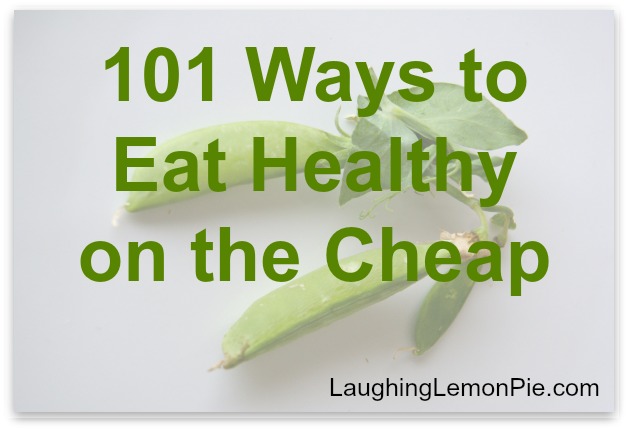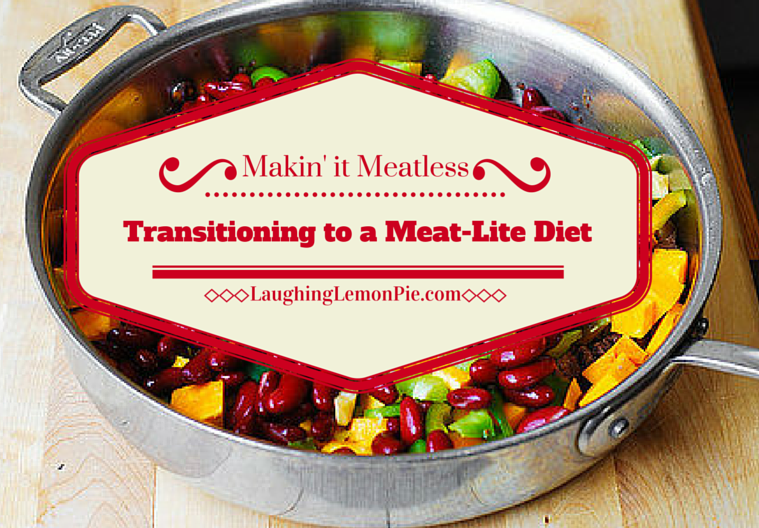Happy new year! I absolutely *love* any excuse for a new beginning, and New Year’s Day is kind of a big one. I gave up making traditional resolutions a while ago in favor of taking small steps all the time to reach bigger goals. So I sat down and brainstormed all the little changes I’ve made to get to a much bigger goal: eating healthfully, naturally, and CHEAPLY!
These are tips and tricks I’ve tried and relied on during my journey toward healthier eating. Of course, some of them make a bigger impact than others, and not every one will be right for you—your mileage may vary, as they say. But hopefully you’ll find some new-to-you ideas for a healthier diet!
- eat a fruit and a vegetable at every meal
- pre-wash and cut up your fruits and veggies to make them easier to eat
- switch to whole grain everything—bread, pasta, crackers, etc.
- figure out which reduced fat and fat free dairy items you like (for me: reduced fat soft cheeses=yummy; reduced fat hard cheeses=YUCKY)
- add a salad to your meals, especially in the summer
- always keep fun stuff around to add to salads (cherry tomatoes, broccoli slaw, roasted beets, toasted nuts, sharp cheeses—whatever floats your boat)
- make your own salad dressings
- dip your fork in thick salad dressing before each bite, instead of pouring it over your salad (you’ll need less overall)
- add a broth-based veggie soup to your meals, especially in the winter
- try to limit yourself to one trip to the store per week (to avoid impulse buys)
- eat meatless meals at least once a week
- figure out how to use less meat in your favorite recipes
- figure out how to add more veggies to your favorite recipes
- commit to buying ethically-raised meat; BELIEVE ME, you will eat less of it because it’s so expensive
- eat veggies for breakfast
- plan your meals ahead of time
- shop at the farmer’s market
- switch all your “white” grains to whole grains
- eat more beans (and cook them yourself!)
- make DIY versions of your favorite processed treats (you’ll almost certainly eat them less often if you have to make them yourself)
- make sure you’re drinking rBGH-free milk
- pick your own produce when you can (Healthy food and exercise! It’s a two-for-one!)
- store hearty fruits and veggies in a DIY root cellar over winter
- cut processed corn out of your diet
- preserve produce at its peak—and lose all the crazy chemicals you might get buying it from a store
- learn to cook less-popular cuts of meat to make it cheaper and go further
- make your own white sauce instead of using cream of whatever soups in recipes
- ditch the cold cereal—it’s expensive and not that nutritious—and try oatmeal
- If you order Chinese food out, also get an order of steamed veggies and mix them in with your entree; there’s plenty of sauce to go around and you’ll end up eating less of the fattier meats. This is a great way to save money, too: get one entree and one veggies and split it with a friend.
- If you eat prepared soups, frozen dinners, mac n’ cheese, etc., add extra veggies; frozen veggies are cheap and easy to add to everything.
- always have frozen organic spinach on hand—one of the cheapest and easiest veggies to keep around
- eat more eggs
- make your own bread—and leave out all the corn syrup and other nasties
- split an entree when you go out with friends
- order an appetizer instead of an entree when you eat out
- ask for a take away box at the beginning of your restaurant meal, and pack up half to take home right away
- better yet, eat out a LOT less
- avoid processed foods (even organic ones!)
- pack your own healthy snacks to ward off temptation while you’re out
- drink more water—from the tap in a reusable bottle, of course
- buy grains, beans, and spices from the bulk bins
- learn to use coupons—sanely
- add fish to your diet at least once a week
- switch to mustard instead of mayo
- use salsa on salads and baked potatoes
- swap fat free Greek yogurt for sour cream
- buy whole chickens and turkeys and use it all
- make your own chicken stock or vegetable stock
- make your own spray oil for cooking
- don’t drink juice; eat a piece of fruit instead
- try lemon juice, herbs, or vinegar on your veggies instead of butter or oil
- eat a piece of fruit and drink a glass of water if you’re hungry between meals; then wait 20 minutes and decide if you’re still hungry
- eat a healthy snack before you go grocery shopping to help avoid impulse buys
- cut out canned foods (unless you canned it yourself!)
- buy only products with ingredients you recognize
- make your own granola bars, trail mix and “100 calorie” packs
- learn what a portion actually looks like
- put your fork down between bites so that you eat more slowly
- always eat sitting down at a table
- don’t do anything else while eating (no reading, surfing, texting, or watching tv; talking to loved ones is OK!)
- try a CSA (community supported agriculture program)
- grow your own _________ (whatever you have room for)
- go generic—there are more and more organic brands to choose from
- brown bag your lunch to work
- drink your coffee black
- slowly change the kinds of snacks you keep around from unhealthy and processed to healthy and unprocessed
- find healthy treats to keep you from feeling deprived like dark chocolate, dried fruits, sorbet—whatever makes your sweet tooth sing
- if you like creamy dips, make them with fat free cottage cheese (pureed in the food processor) or fat free Greek yogurt to increase the protein
- store cut veggies like carrots and celery in water to keep them fresh longer
- freeze leftover herbs, citrus rind, wine, coffee, etc. to use later
- switch to real butter instead of margarine and use in moderation—but enjoy every bite
- learn how to properly store all your fresh foods to reduce food waste
- cut back on the amount of dairy you eat; it’s not as essential as the dairy council would like us to believe
- buy raw nuts and toast and season them yourself
- focus on buying ingredients at the store instead of already prepared foods
- swap boneless chicken thighs for breasts in many recipes
- skip the grocery store rotisserie chicken (lots of extra fat and salt) and roast your own chicken
- avoid products that make health claims on the label (lowers cholesterol! heart healthy! etc.)
- in fact, avoid products that have labels at all (fruits and veggies don’t!)
- give up looking at calories; they aren’t a good overall picture of nutrition
- in fact, give up thinking about “nutrition” in general, and aim for a varied diet based on whole foods
- air pop your popcorn or pop it in the microwave—and skip the expensive (and chemical laden) microwave popcorn
- swap sweet potatoes for white potatoes whenever you can
- eat fruit for dessert
- aim for at least 2–3 different colors on your plate to get lots of different vitamins and minerals
- add variety to your diet
- learn to listen to your body and try to stop eating for reasons other than hunger
- try a new fruit or vegetable whenever you can—you never know what you might like!
- experiment with new herbs and spices from the bulk section: you can buy just enough to try
- cook healthy foods ahead of time in bulk so you’ll have them on hand: things like beans, rice and other grains, and roasted veggies store well and make easy, healthy additions to meals
- cut back on supplements; if you’re eating a varied diet, you shouldn’t need them (unless your doctor tells you otherwise, of course)
- plan your meals around what’s on sale
- don’t buy beverages other than milk
- learn what kinds of wild foods you can easily find in your area
- don’t buy any food that comes in a single-serve package (unless it’s an apple or banana!)
- use dried herbs in place of fresh or grow your own (fresh herbs cost a bundle)
- sign up for your favorite stores’ rewards programs and use them
- bring your own bags (five cents cash back! WOOT!)
- give up “meat alternatives” (like soy dogs and chickn nuggets) or learn to make your own
- cut back on food “drugs:” sugar, caffeine, and alcohol
- practice the 80/20 rule and let yourself splurge once in a while





You know I stood up and gave you an ovation for #101!
Aww, thanks! 🙂